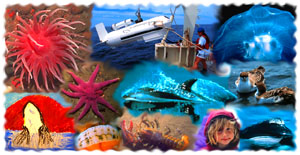|
Sand and gravel banks, muddy basins, rocky ledges, and vast boulder fields provide a variety of productive habitats within the Sanctuary. These productive reef environments are analogous to the tropical coral reefs -- just deeper, darker and colder. Stellwagen Bank reaches up from depths leveling off at an average of 100 feet below the waters' surface. The bank's shallow southwest corner has a depth of only 65 feet. Winter storms, the infamous "nor'easters", advance across the Gulf of Maine with enough energy to reach down and sweep sand grains along the top of the bank. Gravel and coarser sand have been left behind on the eastern side of the bank, while fine sand collects on the west and mud fills Stellwagen Basin. Ancient gouges in the seafloor of the northeastern corner of the sanctuary were caused by icebergs that grounded in the muddy sand at the close of the last period of glaciation. Stellwagen Bank National Marine Sanctuary provides habitat for variety of marine creatures including the endangered northern right whale, humpback whale, finback whale and Atlantic white-sided dolphin. Atlantic bluefin tuna, Atlantic cod, winter flounder, sea scallops and northern lobsters travel through Stellwagen. Forty species of sea birds wheel their way above Stellwagen Bank's wild ocean including Wilson's storm petrel, shearwaters, northern fulmar, and northern gannet, terns, gulls and in the winter, a rich assortment of alcids and large numbers of black-legged kittiwakes. Mature sea turtles such as the impressive leatherback and loggerhead, and pinnipeds--harbor and gray seals--are also spotted in the sanctuary. And one won't soon forget the ungainly appearance of a drifting ocean sunfish, the blue flash of the sleek bluefin tuna, or the cavernous maw of the (relatively) toothless basking shark. The sanctuary is fueled by a rich abundance of phytoplankton and zooplankton. Golden-brown diatoms cause the waters to appear murky green. Healthy phytoplankton blooms lead to hearty zooplankton blooms, which in turn bring many larger animal species. Areas within the sanctuary are believed to be nurseries, supporting young fish and shellfish such as cod, flounder, sea clams and lobster. The Bank is also home to a vast array of invertebrates: sponges, soft corals, anemones, sea stars, sand dollars and sea urchins, marine worms, mollusks and squid. Since colonial times, countless vessels have traversed the waters that today encompass the Stellwagen Bank Sanctuary. Whether through hurricanes and other storms or human error, ships have foundered and sunk in the area. It is not believed that there
was any human habitation of the Stellwagen Bank
area before it sank beneath the waves as sea level
rose. However, the area had at one time supported
vegetation and terrestrial animals, including
mastodon and mammoth. Bones and teeth from these
beasts have been recovered by fishing gear from the
area.
|
||||||


